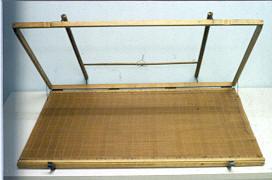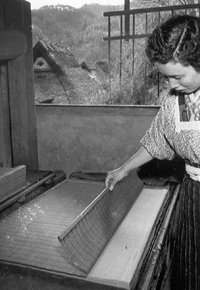Neri
The adding of vegetable mucilage, commonly called neri, is essential to the formation of a sheet of Washi. Mixing neri into the pulp suspended in water allows for the even dispersal of the fibers throughout the vat. The papermaker can also control the rate at which water filters through the screen by varying the amount of neri in the solution. Its addition also makes it possible to separate the newly formed pieces after pressing without the use of couching sheets or dividers.
Neri is most commonly derived from the root of the tori-aoi a plant similar to Hibiscuses found in the west. First the root is crushed, placed into a strainer, and set in an empty container. After a number of hours, the mucilage that has oozed from the broken root into the waiting container is combined with water. The result is a clear, viscous substance that resembles the mucilage of boiled okra.
Once all of the ingredients have been prepared, the vat is filled with clear, cold water. The papermaker then adds pulp and neri. The mase, a long wooden comb, is used to stir the solution and suspend the cellulose fibers in the water.
(text and background only visible when logged in)

Nagashi-Zuki
One of the most distinguishing features of Japanese paper-making is the method of sheet forming called Nagashi-zuki. The papermaker dips the sugeta (hinged mold) into the vat and brings it up full of solution.
The papermaker then tosses the solution back and forth across the screen. As the water trickles and dances through the bottom of the sugeta, a sheet of pulp is formed on the screen. Any excess solution is tossed off the back of the mold, and the process is repeated three to four times until a sheet with the desired thickness is formed. In this step, the screen is coated with a very thin layer of fibers that are aligned perpendicular to the bamboo in the sugeta. This alignment prevents the fibers from becoming entangled and eases the removal of the sheet. It takes much experience to judge the correct thickness of paper, and the production of the very thinnest pieces of Washi is as difficult as the end product is beautiful. Master papermakers hold that it takes anywhere from two to ten years to master the art of sheet formation.
(text and background only visible when logged in)
Stack
The flexible screen is removed from the mold with the wet sheet of paper still attached. The papermaker then uses the screen to place the fresh wet sheet on the stack of newly formed sheets. The sheets must be precisely aligned to avoid damaging the entire stack during the pressing process.

(text and background only visible when logged in)